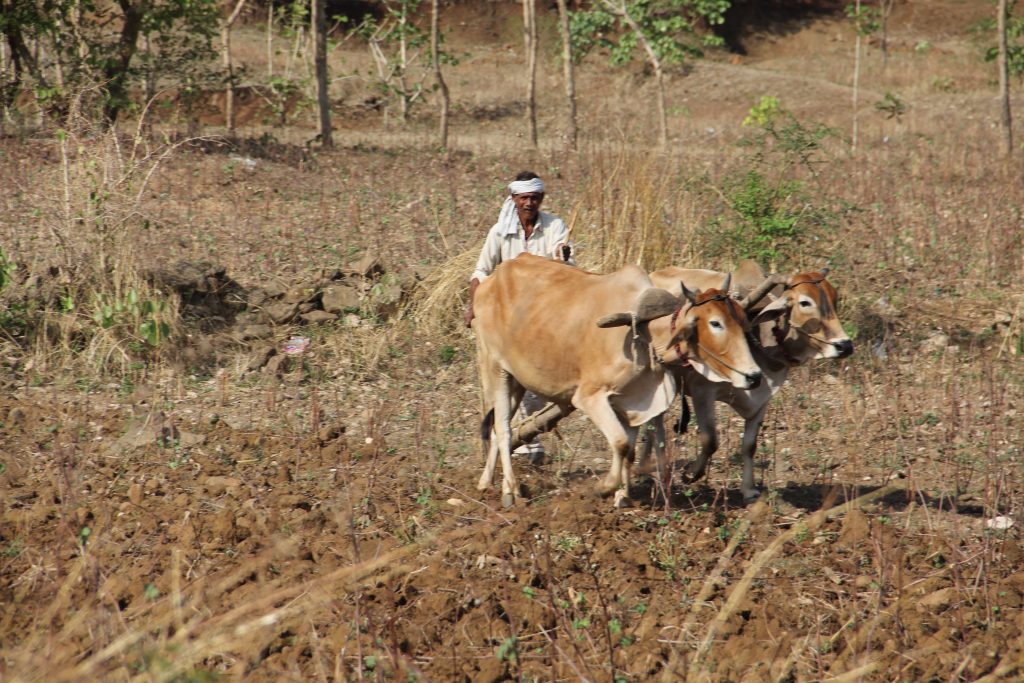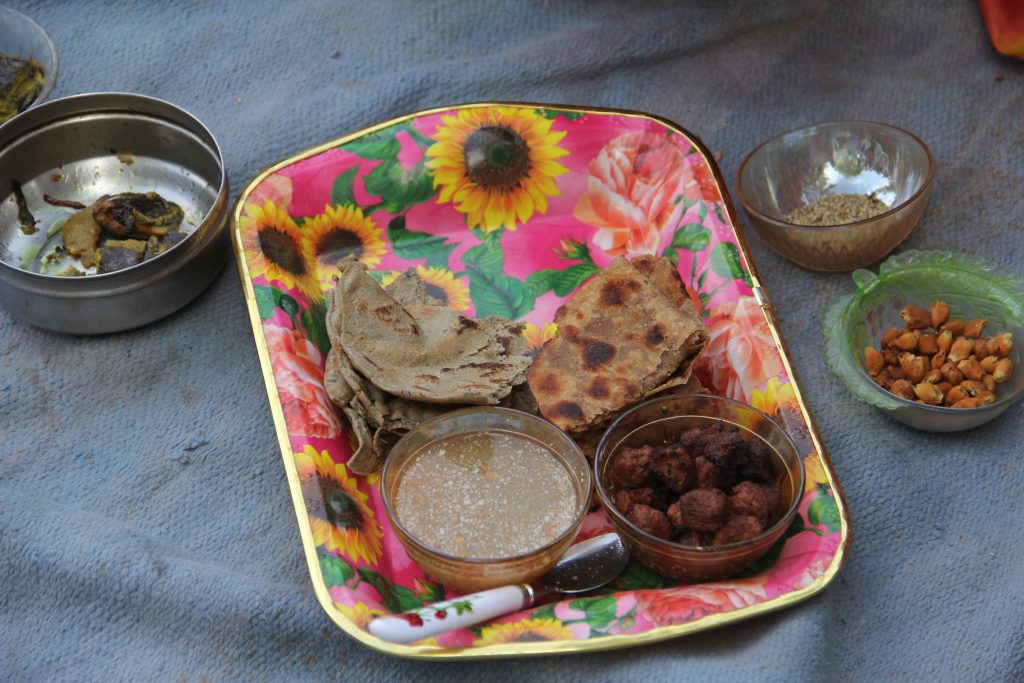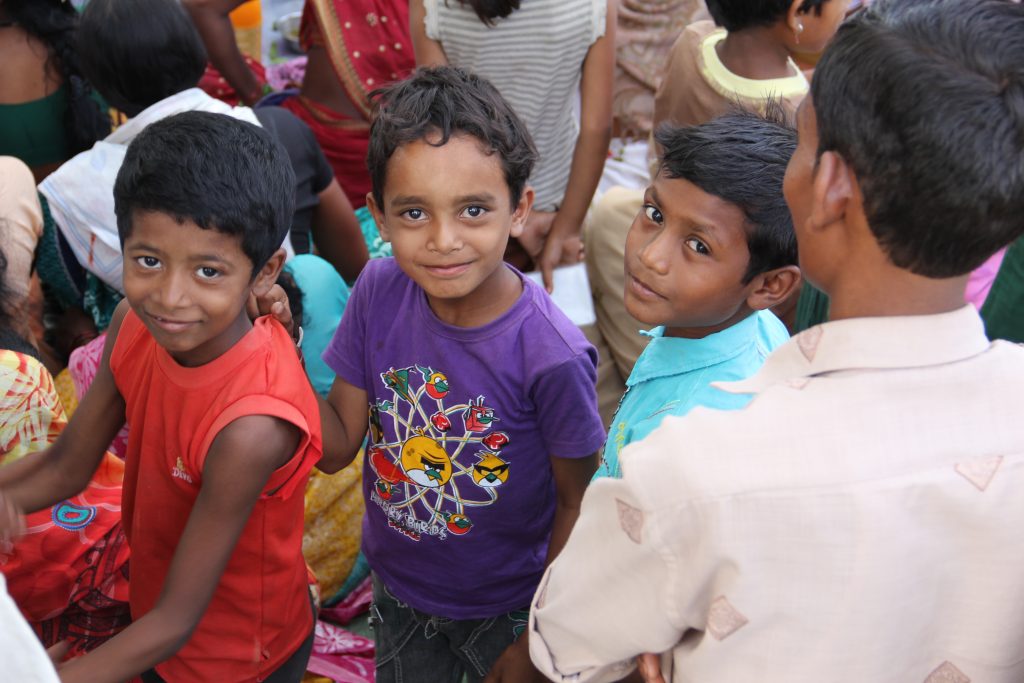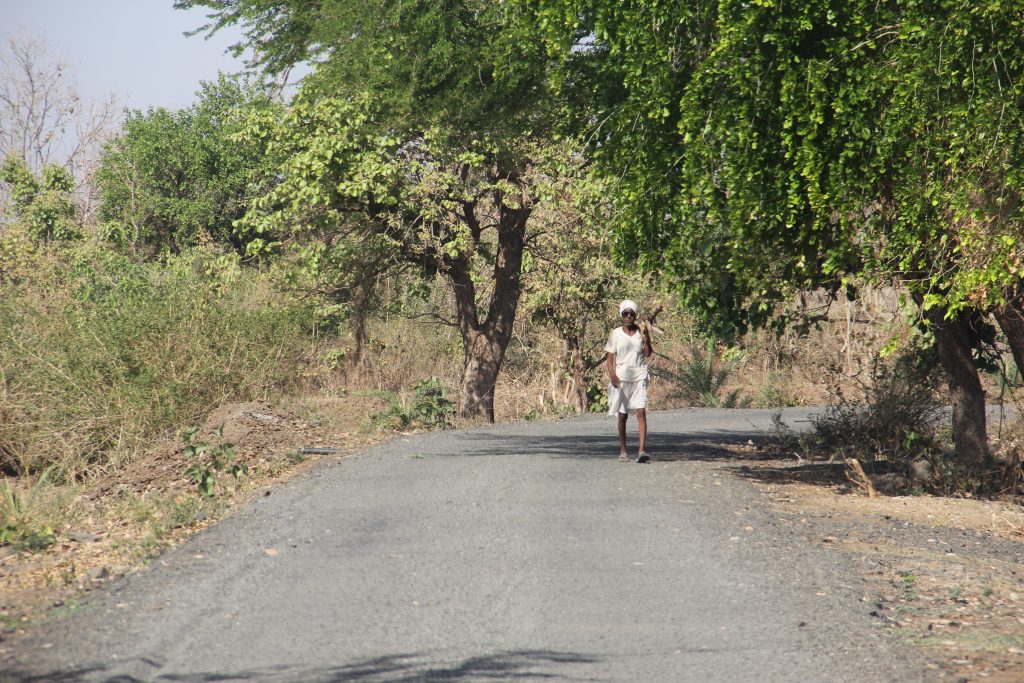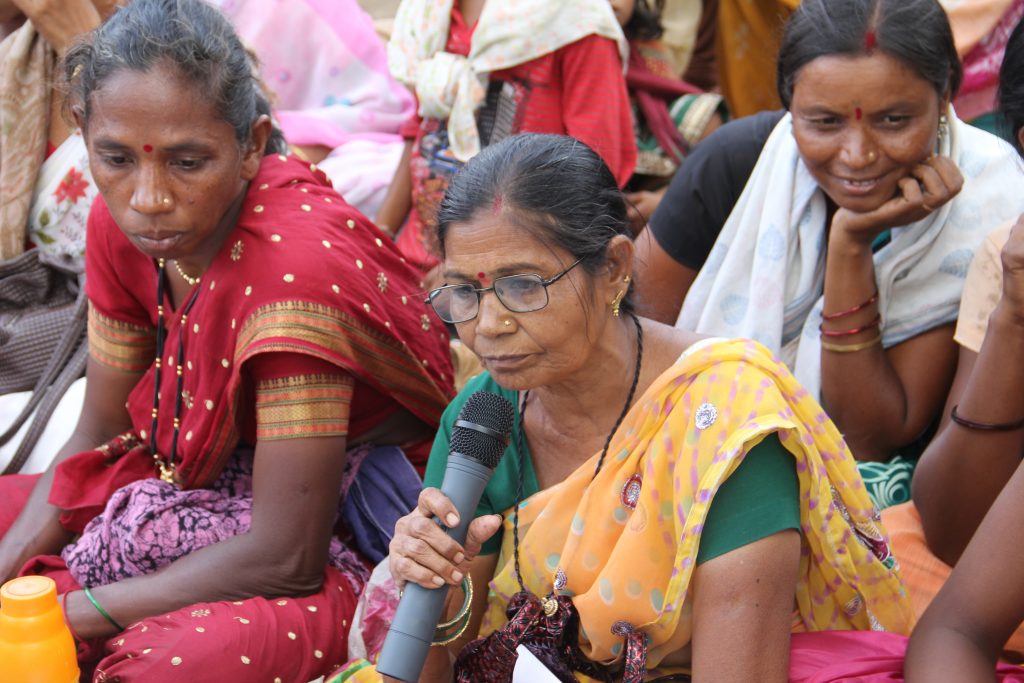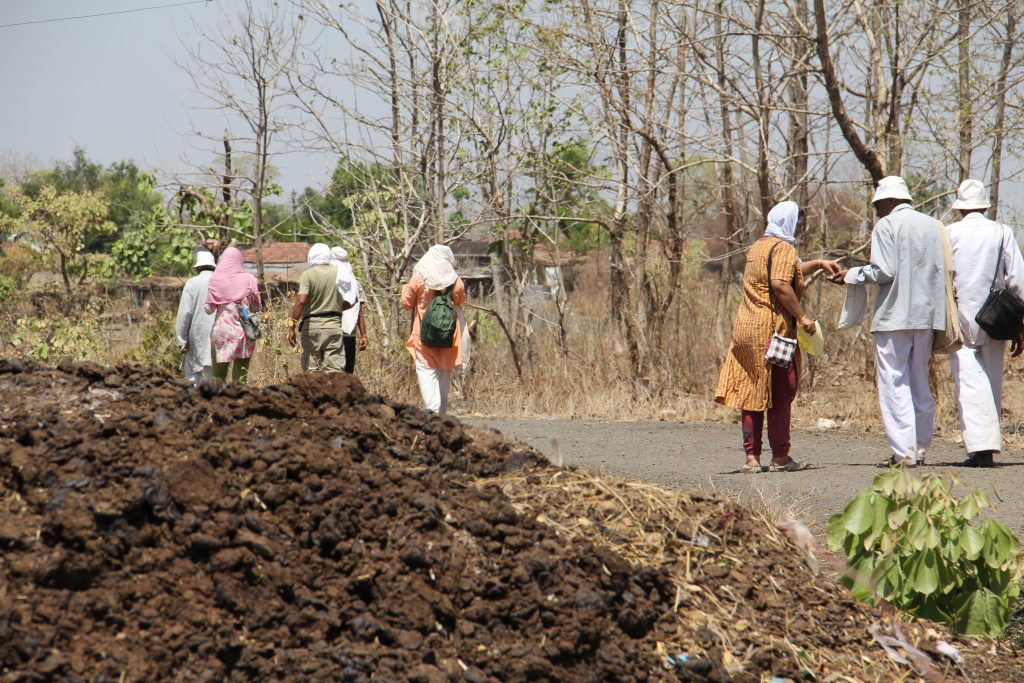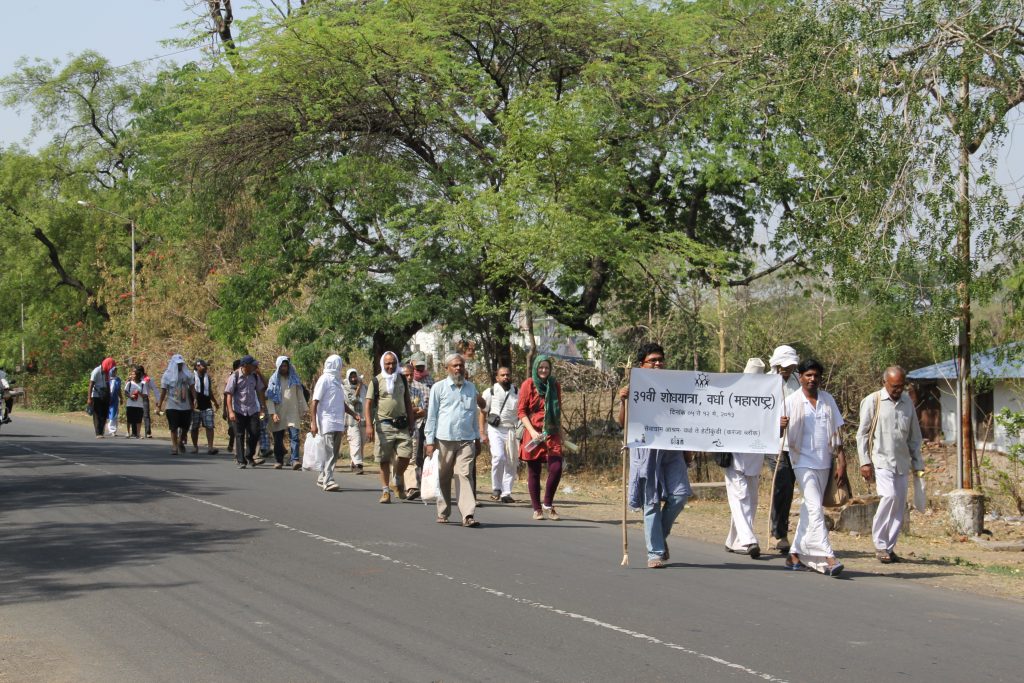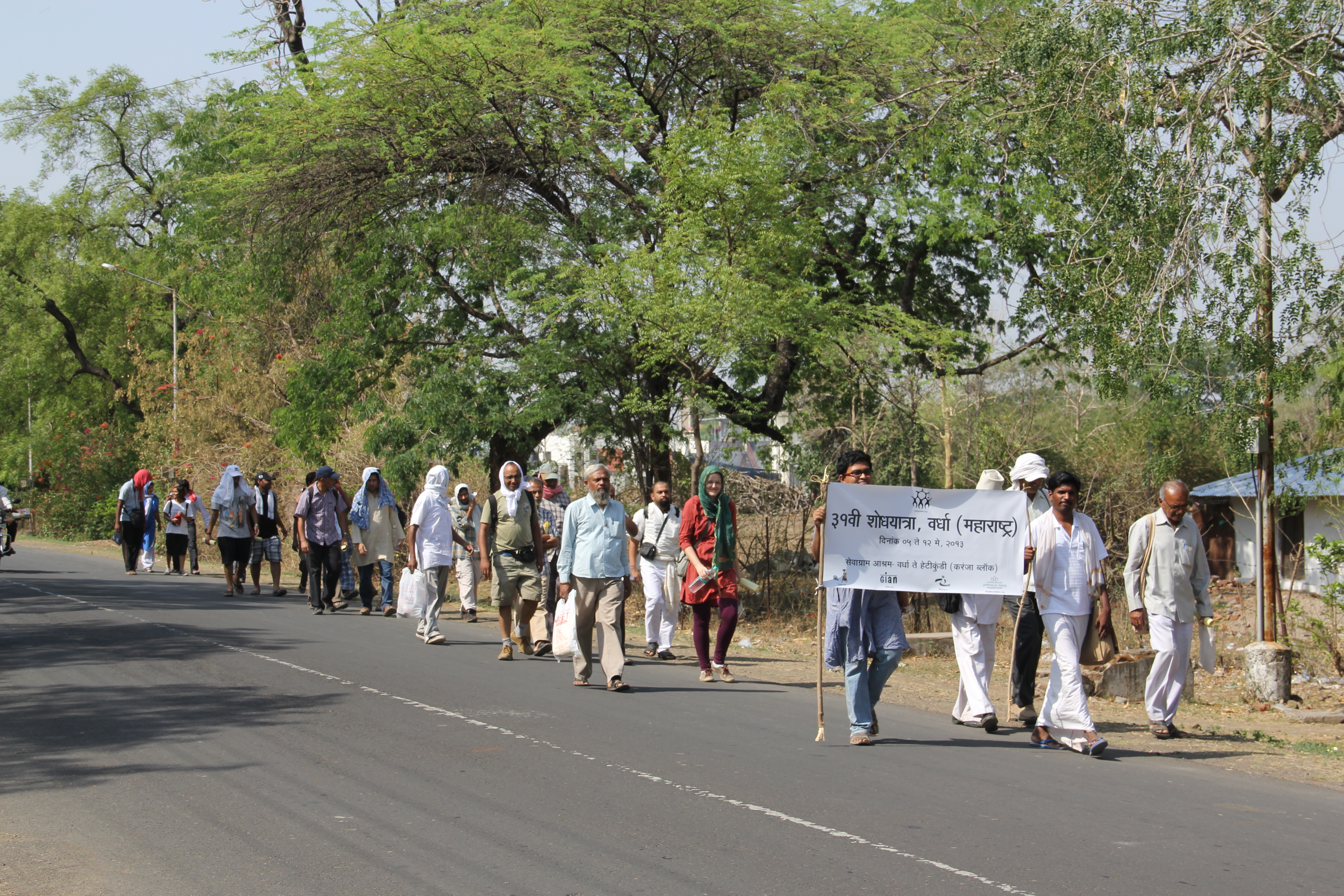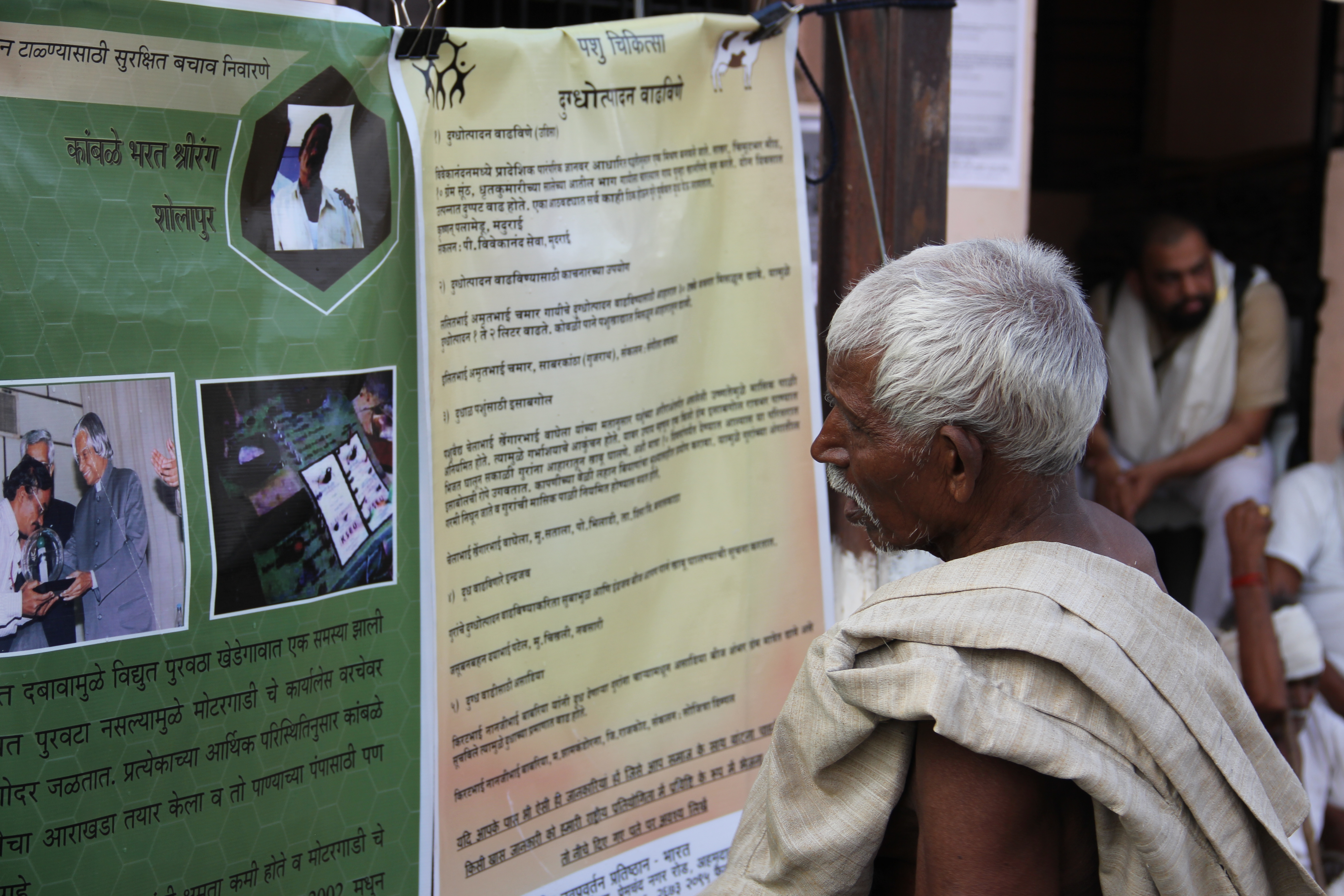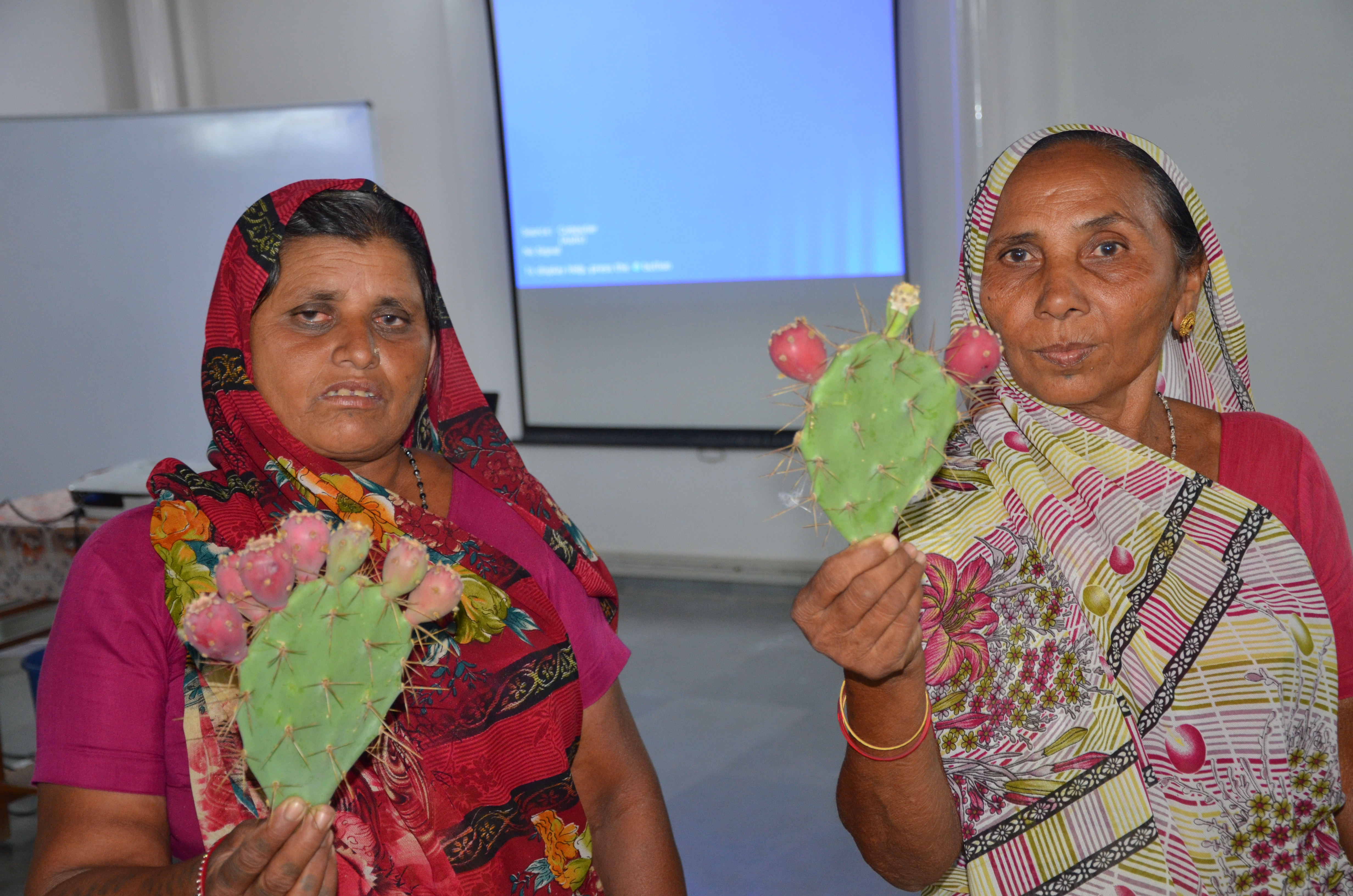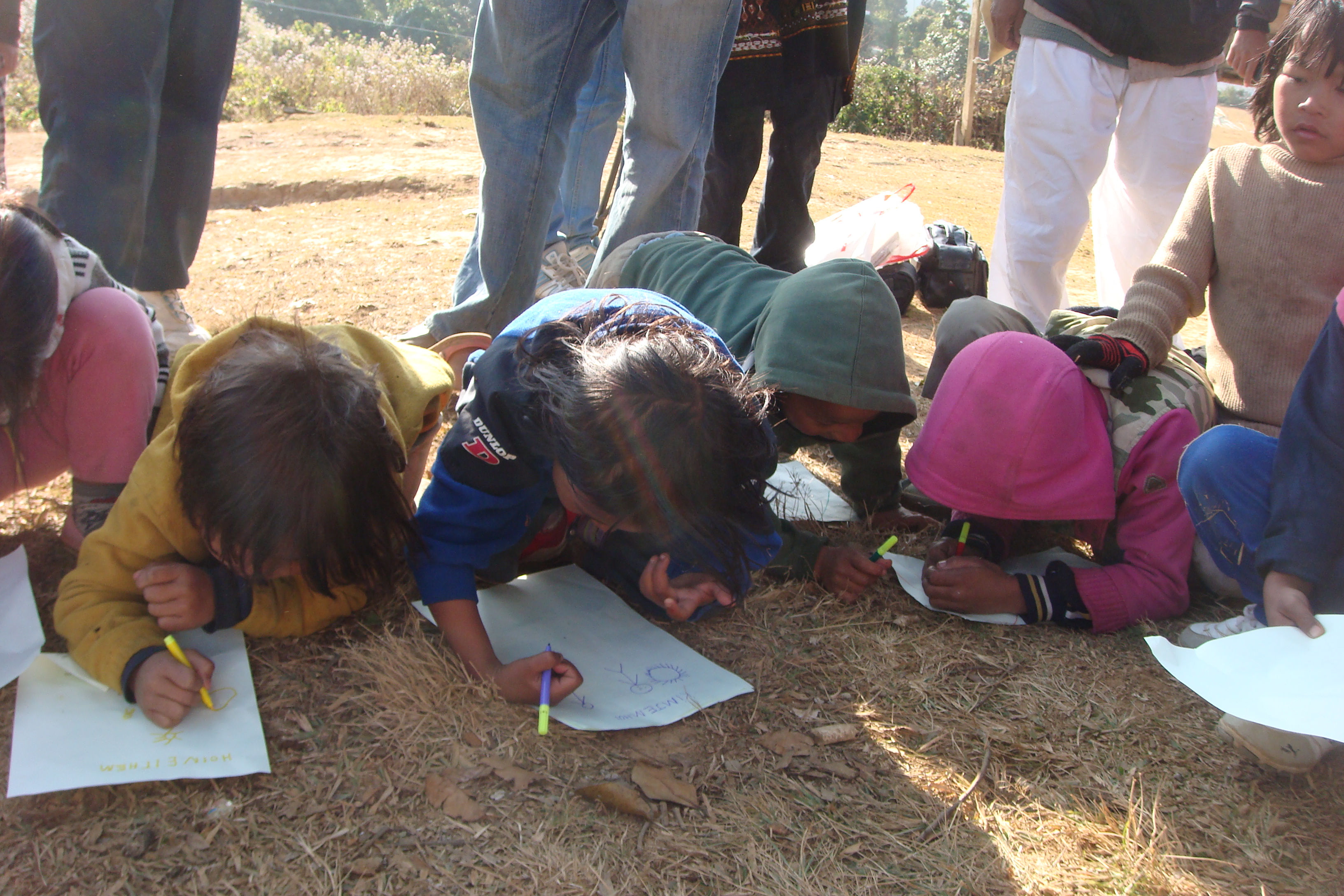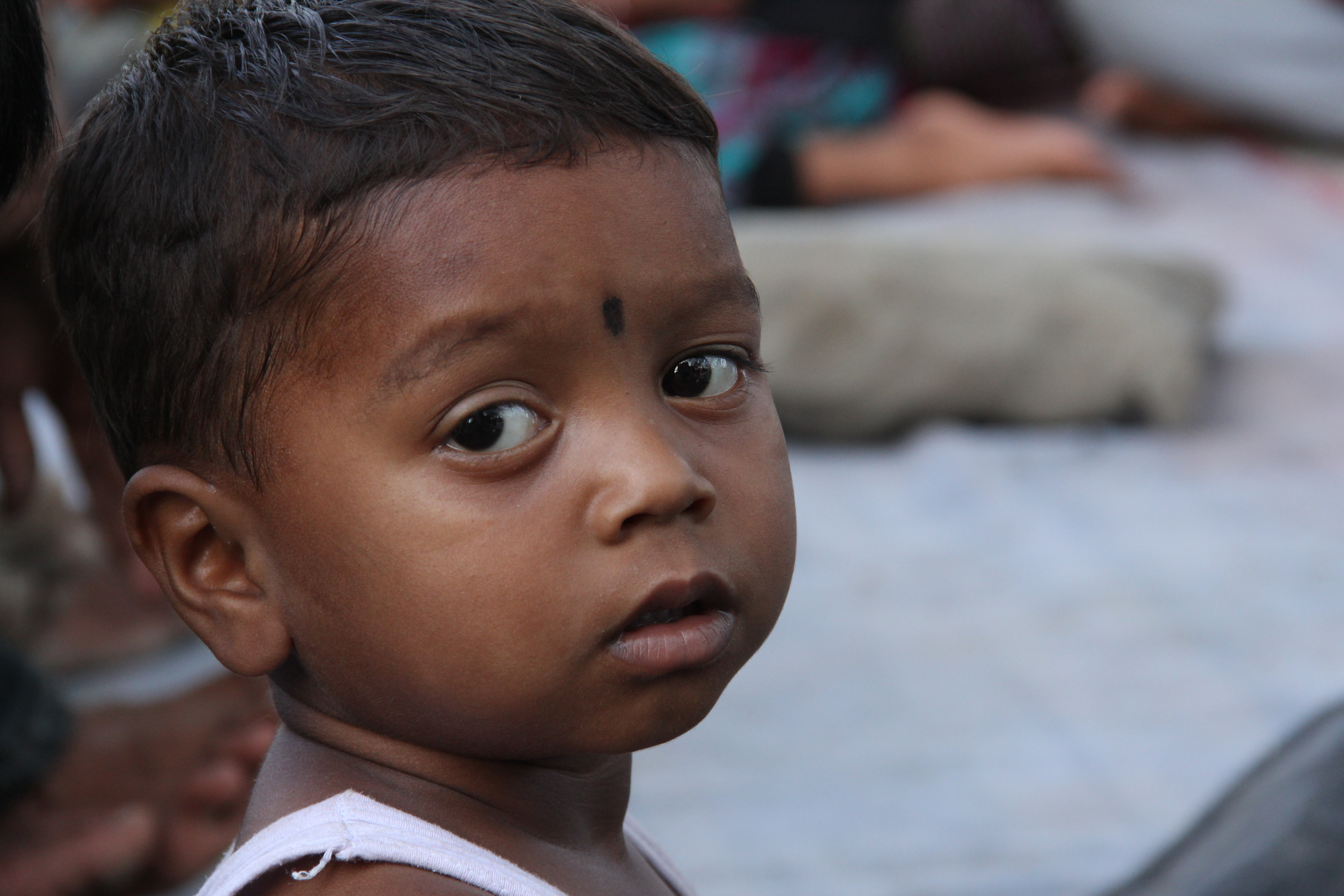Get Next Shodhyatra Update:
Phone:
079-27913293, 27912792
Email:
shodhyatra@sristi.org
31ST SHODHYATRA, SEVAGRAM WARDHA TO MAHARASHTRA
A DIM FLAME OF GANDHIAN LEGACY
Starting from the Gandhi Ashram, Wardha, the shodhyatris walked through different villages to see the ripples of various reconstruction activities that might have been taken up in the hinterland of the ashram. As always, there were many moments of hope, but the yatris also had sights of sadness. After all, this district witnessed many cases of farmers’ suicides because of crop failure. It also faced a huge problem of water scarcity. The yatris absorbed the spirit of many developmental organisations, which were trying hard to rebuild the social fabric that had become weakened over the last few decades. Several innovations were shared on the way to kindle curiosity of the villages, read on…
Gandhi moved to Sevagram in 1936 to create a new crucible of concerted devotion to attain freedom from the colonial rule*. This ashram symbolises not only his principles of frugality in everyday life but also his values about the way a dominated culture deals with power of the ruling elite. When the British government wanted to install a telephone line in the ashram to communicate with Gandhi, he refused at the first instance. After a lot of persuasion, he agreed with the condition that the phone would be one way, i.e., he could receive a call but he would not be able to make one. He had nobody to call. If somebody wanted to communicate with him, she or he could write him a postcard or visit him. There was no other way that he wanted it to happen. In this age of super connectivity when all of us seem to be accessible to each other all the time, he realised the value of frugality even in communication. Perhaps, the depth and density of communication is inversely correlated with frequency. Yet, he was so successful in delivering his messages about freedom struggle to every nook and corner of the country.
The design of the Sevagram, shaped by Gandhi’s biases, offers so many lessons not only for architects but also for planners and development thinkers. Some might be valid in the current times and some might need revisit. He was quite eloquent about his beliefs even if some of these appeared disagreeable to others.
The shodhyatris went through the ashram to absorb its serenity and elements of the embedded history of our freedom struggle. His own cottage was designed by Meeraben. Her simple art work of shelves in the mud wall or the beams or the veranda showed the ease with which she blended her European elegance with Indian simplicity. Since Badshah Khan lived there for a while, the entrance had a cleavage in the portico so designed that he didn’t have to bend his head every time he entered. Attention to small details was a unique trait of Gandhi.
He had a separate cottage for Kasturba where women of the ashram could sit during afternoons spinning charkha and/ or discussing various matters. Most of the visiting leaders, after getting down from the railway station, would walk the rest of the way to the ashram, as it was a kutcha road and there were not many means of local transportation. But Jamnalal Bajaj created an interesting solution to this problem, viz., the OXFord, an old ford car driven by oxen from Wardha to Sevagram Ashram. OXFord often carried Nehru, Rajagopalachari and Patel for consultations with Gandhi.
One could not join Gandhi just like that. He had stipulated in 1941, “Permission to offer satyagraha will not hereafter be granted to newcomers who are able to spin just ordinarily and have worn khaddar recently. They will have to go to villages and do constructive work and those who work for a fixed period and produce details of work done in the villages week by week will be allowed to offer satyagraha”. One had to prove that one had embarked upon the path of social engagement and reconstruction to qualify to be satyagrahi.
A workshop was held on the first day of the shodhyatra at Sevagram with various local voluntary organisations so that the plans for the follow up after the shodhyatra could be discussed in the beginning. We met a few pioneering social entrepreneurs and conservers of agro-biodiversity. Ramesh Shakarkar, for instance, is an extraordinary farmer dedicated to the conservation and distribution of seeds of over two hundred varieties of crops, vegetables and flowers.
The only condition he put on the recipients of these varieties was that, at the time of harvest, they should return twice the quantity of seed that they had taken. Another conserver, Vivek Bharade, had collected more than fifty four varieties of cereals, pulses and oil seeds. Such champions of agro-biodiversity conservation and dissemination must be honoured so that they can inspire masses. SRISTI honoured them and requested them to continue this noble and generous tradition.
A small exhibition was organised to show various innovative prototypes of farm machinery. Vibha explained the way a network of two dozen NGOs in Wardha was trying to spread sustainable alternatives in various domains. Maltitai looked after the dairy activities. She took care of the manger very affectionately. All the shodhyatris were impressed to see how she could call any calf or cow by name and get response from them.
We heard an interesting anecdote about an acquaintance of Gandhi from South Africa who had come to visit him one day. At the time, there was no exclusive guesthouse in Sevagram. When the guest told Gandhi about this inadequacy, Gandhi asked him to build one. And accordingly, a guesthouse with mud walls and tiled roof was built.
In the evening, the shodhyatris went to a nearby village and made a presentation about some of the innovations collected by the Honey Bee Network. Some of the prototypes were also showcased. The local community liked the cycle sprayer developed by Mansukhbhai Jagani very much. One lady farmer wanted to buy it on the spot. Such an enthusiastic response on the very first day boosted the morale of the yatris. The next day, the yatris visited the Lok Niketan Tantrik Vidyalaya in Pipri. This polytechnic has developed several innovative devices for local use.
The faculty and students showed keen interest in the Bullet–Santi (a multipurpose farming machine) presented by the yatris. Given the shortage of bullocks, a multipurpose device which is both affordable and fuel efficient, made a lot of sense. They immediately requested SRISTI to arrange to send an innovator who could fabricate a similar device locally so that they could learn and also diffuse. Accordingly, after the shodhyatra, the innovator Mansukhbhai Jagani spent two weeks in Wardha to develop the device. Because the availability of various parts was rare, the time taken for making the prototype was more than what was normally required.
Large parts of the district were dry and some of the canals built many years before were never used. We met an elderly inmate, Nirmalaben at the Pavnar ashram set up by Vinoba Bhave. The architect of Bhoodan Andolan, Vinoba had set up ashrams and self-reliant farms in different parts of the country on land donated by people for his cause. Nirmalaben shared both her agony of not having many young sarvodaya workers and also her hope that shodhyatris would hopefully carry the unfinished agenda of social development triggered by Gandhiji and Vinobaji.
While passing through long stretches of dryland, the shodhyatris realised that rainwater harvesting had been grossly neglected in this region. The fact that two ponds that we came across during the walk had sufficient water even in the month of May proved that it was possible to conserve water and store it. And yet, there was no project running even under MGNREGA on creating farm ponds, large tanks or other water storage structures. In the backdrop of the large-scale farmer suicides, due to inability to pay back loans borrowed for growing cotton crops, neglect of this kind became even more difficult to understand.
The water tank based rotor sprinkler system designed by Dharamvir from Ambala, Haryana, was a great hit in every village. This device was designed to provide life-saving irrigation. The scourge of Vidarbha is frequent drought and failure of rains at critical stages of the cropping year. Transporting water in a tank and sprinkling it over the crop can actually be the difference between life and death for a farmer. This innovation could not have taken place without the provocation of Former President of India, Smt. Pratibha Patil. She not only posed the challenge but also intimately got involved in the design of the solution. After many variations, she liked this version and had it tested in the Rashtrapati Bhawan. Her intuitive understanding was vindicated by the response of the farmers in different villages.
There is a lot more that we learned in this shodhyatra, for which readers will have to wait for the next issue. Till then, please reflect on the fact that despite Gandhiji’s life long struggle to bring a reorientation in our policies and programmes, we continue to ignore his advice on frugality, self-reliance and social solidarity.
BRICKS OF HOPE
A DROUGHT TO COPE
WARDHA SHODHYATRA PART- II
Wardha should have had a more inclusive model of development given Gandhiji’s long association with the district. But that did not happen. On the contrary, the region was much neglected. How else can one explain almost total absence of rainwater harvesting efforts in the region? Rural enterprises, small farm machineries, and sustainable agriculture also did not get attention, despite so many farmers’ suicides. We walked in the region in search of hope. Meeting a farmer keeping our announcement of innovation competition of 2004 safe in the hope of meeting us someday, made our day. Memories matter..
Not many would expect a brick making woman to have a social media account. But Sumanbai Namdura Sheke proudly asked the yatris to meet her on the web, if they wished so. Her daughter was in a medical college and her son was in school. Her husband mixed clay and sand while she and her mother-in-law moulded the bricks. In a day, they earned about INR 500 after making around a thousand bricks. This was a seasonal work, which meant movement from one place to another after some time. Her face was covered with a scarf, her eyes were beaming with confidence. We had not met many workers with such confidence in their future. After walking further, the yatris noticed a farmer using small vessels to spread water in different parts of the fields. The farmer was trying to save as many plants as he could. Even a small pool of water was important.
In Belgaon village, the community meeting in the evening turned out to be very interesting. A girl got up and said that she did not like men drinking liquor in the village. She also mentioned that parents should not take away the scholarship money, which children got to meet their own expenses. A boy got up and bemoaned the fact that boys would laugh if a girl would sit behind on the cycle.
A small revolution had set in. Young school boys and girls were giving vent to their feelings in the presence of shodhyatris, unmindful of how the elders would take it. It was a revealing experience for the yatris to see so much tolerance among elders and free thinking among children. Not one elderly person tried to snub or reprimand the kids. Lessons in democracy begin early.
Our next destination was Pandharkawda. After sharing various innovations and idea of a village knowledge register, with the farmers, we moved to Ganeshpur where we met Suraj, a class seven student who made a universal mobile charger i.e. it could charge any cell phone battery irrespective of the brand. We know that such chargers are available in the market. But we appreciated his ingenuity in the light of the little access this region has to markets or internet. In Aekbhurji, we sat with the people and noted the local names of about 120 plant samples that we had collected.
After reaching Kheri, we met a hearing and speech impaired student, Archana, who had made beautiful flowers from dried shells of cotton bolls and other agricultural waste. One of the yatris referred to the pieces of bangles used for making various craft goods as broken. The moment he mentioned broken bangles, he was chided by others. In Indian culture, women never liked to use the phrase “broken bangles”. It was considered a very inauspicious expression because only when a woman lost her husband she would break bangles. In different languages different expressions have evolved to convey the accidental breaking. Language holds the key to maintaining sanctity of certain auspicious expectations.
The fear of bear, boar and tigers was engulfing the yatris because it was getting darker and the next village required walking through the forest. Only a few yatris had torches and the stars were not shedding much light. The next day, one could observe a variety of trees sieving the sunlight through bare branches since the summer had taken its toll on leaves. Walking through the forest, everybody feared the tiger but perhaps secretly also wished to see one.
Some of the senior executives of Bajaj Foundation had come to meet the yatris. Perhaps, the walk through the villages was a worthwhile learning experience for them.
In Kherwada village, where yatris had lunch, several tribal musicians played their instruments including a big drum. During their performance, they narrated their devotion to the deity and also celebrated the mood and the meandering meanings.
In several villages, the demonstration of a cycle based sprayer, a rotor sprinkler mounted on the water tanker and a few other innovations got considerable public attention. The sprinkler mounted on the tanker seemed to answer a felt need for providing life-saving irrigation in a region where there were hardly any water sources. One needed about 20,000 litres to save one acre of crop. The idea of such a tanker had evolved through several iterations under the guidance of the Former President of India, Mrs Pratibha Devisingh Patil. She had shared with NIF her concern about frequent crop failure in Vidarbha.
Initially, she suggested a small device, which could carry water on a mobile platform for irrigating the cotton fields. Three grassroots innovators made different variations of the device which could provide a kind of drip irrigation in the root zone of standing crop. However, the final form of a rotor sprinkler mounted on a water tank seemed a far more effective solution for providing life-saving irrigation to a crop under stress.
Dharambir who had received the President’s award for his Multipurpose Food Processing Machine had designed this tanker under the guidance of Mrs Patil. He demonstrated the device village after village, generating curiosity as well as invoking appreciation among the people.
The next day, we reached Kinnara village which had several contrasts. There were many small houses and a few very large houses, too. One such house had beautifully stained glass windows. Sunlight fell filtered through these glasses on some old books, diaries and manuscripts lying rather uncared for. Once upon a time, it might have been a house of a prosperous person whose grandchildren had now come on a bad time, it seemed. The owner informed that the house walls were made by mixing lime, sand, leaves and fruits of stone apple.
The women had brought a lot of recipes to showcase in a roadside meeting organised by the Bajaj Foundation volunteers in the next village. The yatris had not seen so much diversity in herbs and the methods of cooking them. Several of the dishes had therapeutic properties.
In Parsodi, the village meeting revealed certain paradoxes in using local resources. This village was famous for making cheese. However, almost 200- 300 litres of whey milk was thrown down the drain every day. People were not aware that whey is a very good growth promoter when sprayed on crops and is also a very nutritious supplement. They also told that the whey when added to gobar gas plant ensures consistent and continuous supply of the gas. When asked as to why they would not give it to children, they mentioned that they used acid to coagulate the milk instead of lime juice. But using lemon instead was a very small cost and could easily be handled. There were several such resources, which were not being optimally utilised in the region. In view of widespread farmer suicides in the region, the need for reducing the cost of cultivation, particularly of plant protection, was very high. In most of the schools, we found posters of chemical pesticides, which could be used at different stages of the crop cycle. There was hardly any reference to biological pest control or non-chemical pest control.
It may be useful to recall a study on Village Knowledge Management Systems to deploy science and technology for preventing suicides. The study was undertaken at IIMA a few years ago for the Department of Science and Technology, Government of India. It was discovered that children of the families where suicides took place had no knowledge of sustainable pest management practices. For instance, growing of lady’s finger crop around the cotton field was one such practice which was reported from Jalgaon in Maharashtra and elsewhere. It could reach the Honey Bee Network in Ahmedabad but could not reach Vidarbha yet. The lady’s finger belongs to the same family as cotton, has similar flowers as cotton and it flowers earlier than cotton. Pests get attracted to it and thus the cotton crop is spared. We shared many such practices in different villages, but the absence of diffusion any such practice surprised the yatris no less.
One of the most memorable moments was in Jhargaon, when a villager brought a poster that had been sent out by NIF in 2004. It was a remarkable moment when we could see in 2013, a nine year old poster preserved by a villager hoping that he might meet us some day. That kind of invisible presence of the Honey Bee Network convinced the yatris that a horizontal culture of lateral learning spreads pervasively. But lest we get too euphoric, let me end on a sad note. We had reached Dhaga village by noon and were struck by a calf lying on the ground under the sun. It had been injured by a tiger a few days earlier. Given the severe fractures in the body, the calf was in no condition to get up. There was a cattle shed for taking care of stray animals and also milk cows. The local staff did not realise, however, that even if the calf was on deathbed, the death need not be painful. Some of the shodhyatris first covered the animal to protect it from the sun. Afterwards, a few others moved it under the shade of a tree and gave some water. Several shodhyatris were upset at the plight of the calf and the initial indifference apparent in the way they saw it lyingunder the sun. The following day it was taken to the hospital. The pain still lingered on.
FLICKR GALLERY
